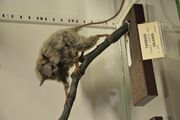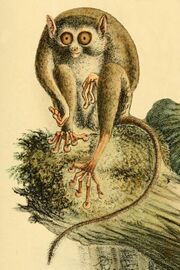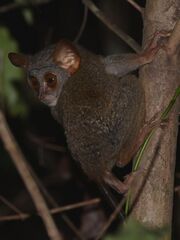Biology:Tarsius
From HandWiki
Short description: Genus of primates
| Tarsius[1] | |
|---|---|

| |
| Spectral tarsier | |
| Scientific classification | |
| Domain: | Eukaryota |
| Kingdom: | Animalia |
| Phylum: | Chordata |
| Class: | Mammalia |
| Order: | Primates |
| Suborder: | Haplorhini |
| Family: | Tarsiidae |
| Genus: | Tarsius Storr, 1780 |
| Type species | |
| Lemur tarsier Erxleben, 1777
| |
| Species | |
| |

| |
| Distribution and range of Tarsius supriatnai and other tarsier species in Sulawesi, Indonesia: Tarsius dentatus Tarsius wallacei Tarsius lariang Tarsius pumilus Tarsius pelengensis Tarsius spectrumgurskyae Tarsius supriatnai Tarsius niemitzi
| |
Tarsius is a genus of tarsiers, small primates native to islands of Southeast Asia. Until 2010, all tarsier species were typically assigned to this genus, but a revision of the family Tarsiidae restored the generic status of Cephalopachus and created a new genus Carlito.[1]
All members of Tarsius are found on Sulawesi, while Cephalopachus is found on Sundaland and Carlito in Greater Mindanao.
Species
| Common name | Scientific name and subspecies | Range | Size and ecology | IUCN status and estimated population |
|---|---|---|---|---|
| Dian's tarsier | T. dentatus Miller & Hollister, 1921 |
Central Sulawesi, Indonesia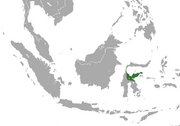
|
Size: 11–12 cm (4–5 in) long, plus 13–28 cm (5–11 in) tail[2][3] Habitat: Forest[4] Diet: Insects, as well as small vertebrates[2] |
VU
|
| Gursky's spectral tarsier | T. spectrumgurskyae Shekelle, Groves, Maryanto & Mittermeier, 2017 |
Northeastern Sulawesi (in purple)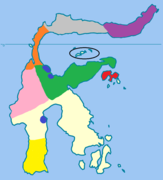
|
Size: About 14 cm (6 in) long, plus 21–27 cm (8–11 in) tail[5] Habitat: Forest[6] Diet: Insects, as well as small vertebrates[6] |
VU
|
| Jatna's tarsier | T. supriatnai Shekelle, Groves, Maryanto & Mittermeier, 2017 |
Northern Sulawesi (in gray)
|
Size: About 14 cm (6 in) long, plus 23–25 cm (9–10 in) tail[5] Habitat: Forest[7] Diet: Insects, as well as small vertebrates[7] |
VU
|
| Lariang tarsier | T. lariang Groves & Merker, 2006 |
Central Sulawesi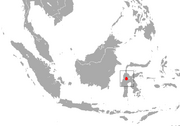
|
Size: About 12 cm (5 in) long, plus 12–21 cm (5–8 in) tail[8] Habitat: Forest[9] Diet: Insects, as well as small vertebrates[9] |
DD
|
| Makassar tarsier | T. fuscus Fischer von Waldheim, 1804 |
Southern Sulawesi (in yellow)
|
Size: 12–13 cm (5 in) long, plus 24–26 cm (9–10 in) tail[10] Habitat: Forest and caves[11] Diet: Insects, as well as small vertebrates[10] |
VU
|
| Niemitz's tarsier | T. niemitzi Shekelle, Groves, Maryanto, Mittermeier, Salim & Springer, 2019 |
Northern Sulawesi (circled in black)
|
Size: About 14 cm (6 in) long, plus 24–26 cm (9–10 in) tail[12] Habitat: Forest[13] Diet: Insects, as well as small vertebrates[13] |
EN
|
| Peleng tarsier | T. pelengensis Sody, 1949 |
Eastern Sulawesi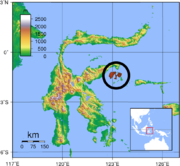
|
Size: 12–14 cm (5–6 in) long, plus 25–27 cm (10–11 in) tail[14] Habitat: Forest[15] Diet: Insects, as well as frogs, lizards, and other small vertebrates[15] |
EN
|
| Pygmy tarsier | T. pumilus Miller, Hollister, 1921 |
Central Sulawesi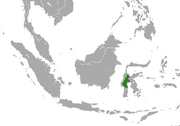
|
Size: 8–11 cm (3–4 in) long, plus 20–21 cm (8 in) tail[16][17] Habitat: Forest[18] Diet: Arthropods and insects, as well as small vertebrates[16] |
EN
|
| Sangihe tarsier | T. sangirensis Meyer, 1897 |
Sangir Island, southeastern Philippines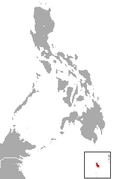
|
Size: 12–13 cm (5 in) long, plus about 30 cm (12 in) tail[19] Habitat: Forest and inland wetlands[20] Diet: Insects, as well as birds, lizards, and other small vertebrates[19] |
EN
|
| Siau Island tarsier | T. tumpara Shekelle, Groves, Merker & Supriatna, 2008 |
Siau Island, north of Sulawesi | Size: 10–15 cm (4–6 in) long, plus about 20 cm (8 in) tail[21] Habitat: Forest[22] Diet: Arthropods, as well as small vertebrates[22] |
CR
|
| Spectral tarsier | T. tarsier (Erxleben, 1777) |
Sulawesi
|
Size: 9–14 cm (4–6 in) long, plus 20–26 cm (8–10 in) tail[23] Habitat: Forest[24] Diet: Insects, as well as lizards, bats, and other small vertebrates[23] |
VU
|
| Wallace's tarsier | T. wallacei Merker, Driller, Dahruddin, Wirdateti, Sinaga, Perwitasari-Farajallah & Shekelle, 2010 |
Northern Sulawesi (in orange)
|
Size: 11–13 cm (4–5 in) long, plus 23–27 cm (9–11 in) tail[25] Habitat: Forest and inland wetlands[26] Diet: Insects, as well as small vertebrates[25] |
VU
|
(As of 2018), Fossilworks also recognizes the following additional extinct species:[27]
References
- ↑ 1.0 1.1 Groves, C.; Shekelle, M. (2010). "The Genera and Species of Tarsiidae". International Journal of Primatology 31 (6): 1071–1082. doi:10.1007/s10764-010-9443-1.
- ↑ 2.0 2.1 Yang, Liubin (2007). "Tarsius dentatus". University of Michigan. https://animaldiversity.org/accounts/Tarsius_dentatus/.
- ↑ Supriatna, p. 49
- ↑ 4.0 4.1 Shekelle, M. (2020). "Tarsius dentatus". IUCN Red List of Threatened Species 2020: e.T21489A17977790. doi:10.2305/IUCN.UK.2020-3.RLTS.T21489A17977790.en. https://www.iucnredlist.org/species/21489/17977790.
- ↑ 5.0 5.1 Shekelle, M.; Groves, C. P.; Maryanto, I.; Mittermeier, R. A. (2017). "Two new tarsier species (Tarsiidae, Primates) and the biogeography of Sulawesi, Indonesia". Primate Conservation 31: 61–69.
- ↑ 6.0 6.1 6.2 Shekelle, M. (2020). "Tarsius spectrumgurskyae". IUCN Red List of Threatened Species 2020: e.T162336422A162336580. doi:10.2305/IUCN.UK.2020-3.RLTS.T162336422A162336580.en. https://www.iucnredlist.org/species/162336422/162336580.
- ↑ 7.0 7.1 7.2 Shekelle, M. (2020). "Tarsius supriatnai". IUCN Red List of Threatened Species 2020: e.T162336881A220971513. doi:10.2305/IUCN.UK.2020-3.RLTS.T162336881A220971513.en. https://www.iucnredlist.org/species/162336881/220971513.
- ↑ Supriatna, p. 45
- ↑ 9.0 9.1 9.2 Shekelle, M; Salim, M.; Merker, S. (2020). "Tarsius lariang". IUCN Red List of Threatened Species 2020: e.T136319A17978130. doi:10.2305/IUCN.UK.2020-3.RLTS.T136319A17978130.en. https://www.iucnredlist.org/species/136319/17978130.
- ↑ 10.0 10.1 Supriatna, pp. 40–41
- ↑ 11.0 11.1 Shekelle, M. (2020). "Tarsius fuscus". IUCN Red List of Threatened Species 2020: e.T162369593A162369616. doi:10.2305/IUCN.UK.2020-3.RLTS.T162369593A162369616.en. https://www.iucnredlist.org/species/162369593/162369616.
- ↑ Shekelle, M.; Groves, C. P.; Maryanto, I/; Mittermeier, R. A.; Salim, A/; Springer, M/ S. (2019). "A new tarsier species from the Togean Islands of Central Sulawesi, Indonesia, with references to Wallacea and conservation on Sulawesi". Primate Conservation 33: 1–9.
- ↑ 13.0 13.1 13.2 Shekelle, M. (2020). "Tarsius niemitzi". IUCN Red List of Threatened Species 2020: e.T162337005A171341769. doi:10.2305/IUCN.UK.2020-3.RLTS.T162337005A171341769.en. https://www.iucnredlist.org/species/162337005/171341769.
- ↑ Supriatna, p. 53
- ↑ 15.0 15.1 15.2 Shekelle, M. (2020). "Tarsius pelengensis". IUCN Red List of Threatened Species 2020: e.T21494A17977515. doi:10.2305/IUCN.UK.2020-3.RLTS.T21494A17977515.en. https://www.iucnredlist.org/species/21494/17977515.
- ↑ 16.0 16.1 Ford, Trevor (2011). "Tarsius pumilus". University of Michigan. https://animaldiversity.org/accounts/Tarsius_pumilus/.
- ↑ Supriatna, pp. 42–43
- ↑ 18.0 18.1 Shekelle, M; Salim, A. (2020). "Tarsius pumilus". IUCN Red List of Threatened Species 2020: e.T21490A17977980. doi:10.2305/IUCN.UK.2020-3.RLTS.T21490A17977980.en. https://www.iucnredlist.org/species/21490/17977980.
- ↑ 19.0 19.1 Minich, Miriam (2017). "Tarsius sangirensis". University of Michigan. https://animaldiversity.org/accounts/Tarsius_sangirensis/.
- ↑ 20.0 20.1 Shekelle, M. (2020). "Tarsius sangirensis". IUCN Red List of Threatened Species 2020: e.T21493A17977351. doi:10.2305/IUCN.UK.2020-3.RLTS.T21493A17977351.en. https://www.iucnredlist.org/species/21493/17977351.
- ↑ Downey, Kathleen (March 2019). "Siau Island Tarsier, Tarsius tumpara". https://neprimateconservancy.org/siau-island-tarsier/.
- ↑ 22.0 22.1 22.2 Shekelle, M; Salim, A. (2020). "Tarsius tumpara". IUCN Red List of Threatened Species 2020: e.T179234A17977202. doi:10.2305/IUCN.UK.2020-3.RLTS.T179234A17977202.en. https://www.iucnredlist.org/species/179234/17977202.
- ↑ 23.0 23.1 Mogk, Kenzie (2012). "Tarsius tarsier". University of Michigan. https://animaldiversity.org/accounts/Tarsius_tarsier/.
- ↑ 24.0 24.1 Shekelle, M. (2020). "Tarsius tarsier". IUCN Red List of Threatened Species 2020: e.T162369551A17978304. doi:10.2305/IUCN.UK.2020-3.RLTS.T162369551A17978304.en. https://www.iucnredlist.org/species/162369551/17978304.
- ↑ 25.0 25.1 Supriatna, pp. 47–48
- ↑ 26.0 26.1 Merker, S.; Shekelle, M. (2020). "Tarsius wallacei". IUCN Red List of Threatened Species 2020: e.T195277A17977659. doi:10.2305/IUCN.UK.2020-3.RLTS.T195277A17977659.en. https://www.iucnredlist.org/species/195277/17977659.
- ↑ Tarsius Storr 1780 (tarsier) at fossilworks.org (retrieved 24 November 2018)
- ↑ Beard, K. Christopher; Qi, Tao; Dawson, Mary R.; Wang, Banyue; Li, Chuankuei (1994). "A diverse new primate fauna from middle Eocene fissure-fillings in southeastern China". Nature 368 (6472): 607. doi:10.1038/368604a0. PMID 8145845. Bibcode: 1994Natur.368..604B.
- ↑ Chaimanee, Y.; Lebrun, R.; Yamee, C.; Jaeger, J.-J. (2010). "A new Middle Miocene tarsier from Thailand and the reconstruction of its orbital morphology using a geometric-morphometric method". Proceedings of the Royal Society B: Biological Sciences 278 (1714): 1956–1963. doi:10.1098/rspb.2010.2062. PMID 21123264.
Sources
- Mammal Species of the World. 1 (3rd ed.). Johns Hopkins University Press. 2005. ISBN 978-0-8018-8221-0.
- Supriatna, Jatna (2022). Field Guide to the Primates of Indonesia. Springer Nature. ISBN 978-3-03-083206-3.
External links
Wikidata ☰ Q60205 entry
 |

